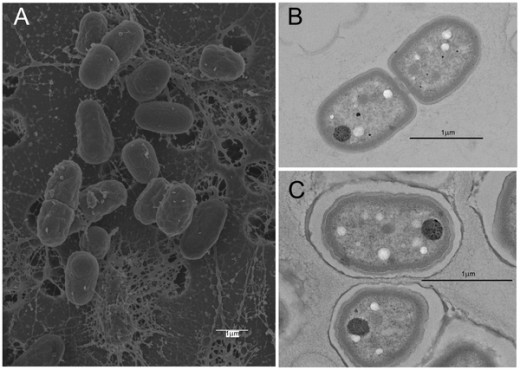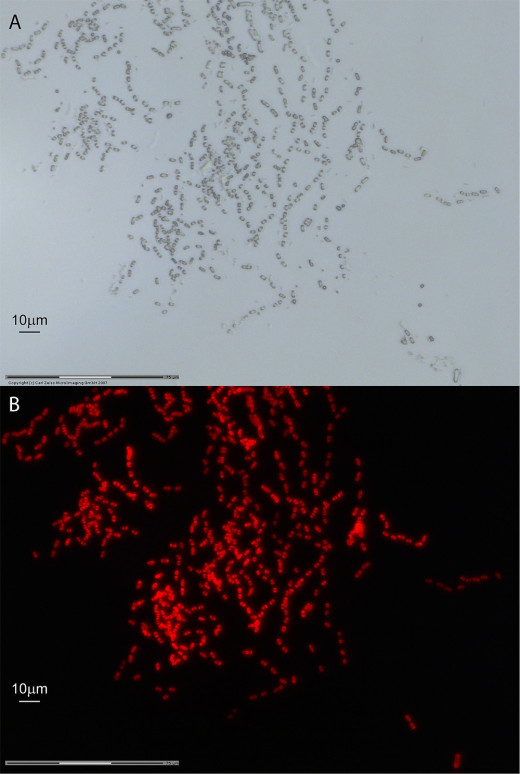
(from the Research article) Figure 1. Scanning electron micrograph of Gloeobacter kilaueensis JS1T cells grown in modified BG-11 liquid medium. Dividing cells are near the top and left of the image. Note mucilaginous material among the cells. Scale bar is 1 µm.
HAWAII VOLCANOES NATIONAL PARK, Hawaii – A new species has been found – so far in only one cave in Kilauea Caldera on Hawaii Island – and scientists at the University of Hawai‘i at Mānoa say it has not been found anywhere else in the world.
“We cultivated a new cyanobacterium from an almost 100-year-old lava cave in volcanically active Kilauea Caldera,” said Associate Professor Stuart Donachie in the Department of Microbiology at the College of Natural Sciences in a media release.
The scientists sequenced the life form’s genome and confirmed that it is only the second-known species in the Gloeobacter genus, the first species of which was described almost 40 years ago.
The researchers reported their finding in an October 23, 2013 article in the scientific journal PLOS ONE, “Cultivation and complete genome sequencing of Gloeobacter kilaueensis sp. nov., from a lava cave in Kīlauea Caldera, Hawai’i.”
The research article suggests the species may be a “missing link” in the cyanobacteria lineage, having “primordial characteristics”. The article summarizes in its introduction:
| Cyanobacteria are among the most diverse and successful microbes on Earth. As pioneers of oxygenic photosynthesis they permanently changed Earth’s atmosphere by emitting gaseous diatomic oxygen, paving the way for the evolution of aerobic metabolism. Gloeobacter violaceus refers to the modern representative of an early branching cyanobacterium that diverged from other cyanobacteria before the emergence of plant plastids [1], [2], and which is thought to be one of the earliest cyanobacteria capable of oxygenic photosynthesis. It is thus considered an intermediary organism due to its primordial characteristics [3]. G. violaceus is also unique because it lacks the thylakoid membranes essential in all other cyanobacteria and plant plastids as the sites of light-dependent reactions in photosynthesis [4]. The absence of these membranes from G. violaceus has led to speculation that the genus may host the earliest ancestors, or a missing link, in the cyanobacteria lineage [3]. However, no other Gloeobacter species has been named since the original description in 1974. |
“While investigating microbial diversity in Hawaiian lava caves,” the article recounts, “we collected samples for molecular and cultivation work from a purple-pigmented epilithic biofilm on the entrance wall of a cave in volcanically active Kīlauea Caldera…. The cave is ~800 m from the volcanically active Halema’uma’u pit crater. As volcanic activity here increased through 2009, temperatures 25 m into the cave ranged from 35 to 40°C, and relative humidity exceeded 100%; condensation formed on all surfaces, and the cave floor was hot to the touch. Immediately below the cave’s ~1 m2 ground-level entrance, the air temperature was ~30°C, and condensation flowed over and dripped from the epilithic biofilm.”
The article goes on to detail the characteristics and features of the G. kilaueensis JS1T genome.
“It’s a great find because both species represent an entire taxonomic order distinct from the other 7,500 known cyanobacteria species,” said Donachie. “They lack the photosynthetic membranes that are found in all those 7,500 species, which means they are also the most primitive known cyanobacteria.”

(from research article) Autofluorescent Gloeobacter kilaueensis JS1T cells observed under bright field (A) and fluorescent microscopy (B). Both fields recorded through a 63× objective with oil immersion on a Zeiss PALM Laser Capture Microdissection MicroBeam IV system. Dividing cells are visible. Scale bar = 10 µm.

by Big Island Video News4:34 pm
on at
STORY SUMMARY
HAWAII VOLCANOES NATIONAL PARK, Hawaii – A new species has been found – so far in only one cave in Kilauea Caldera on Hawaii Island – and scientists at the University of Hawai‘i at Mānoa say it has not been found anywhere else in the world. “We cultivated a new cyanobacterium from an almost 100-year-old […]